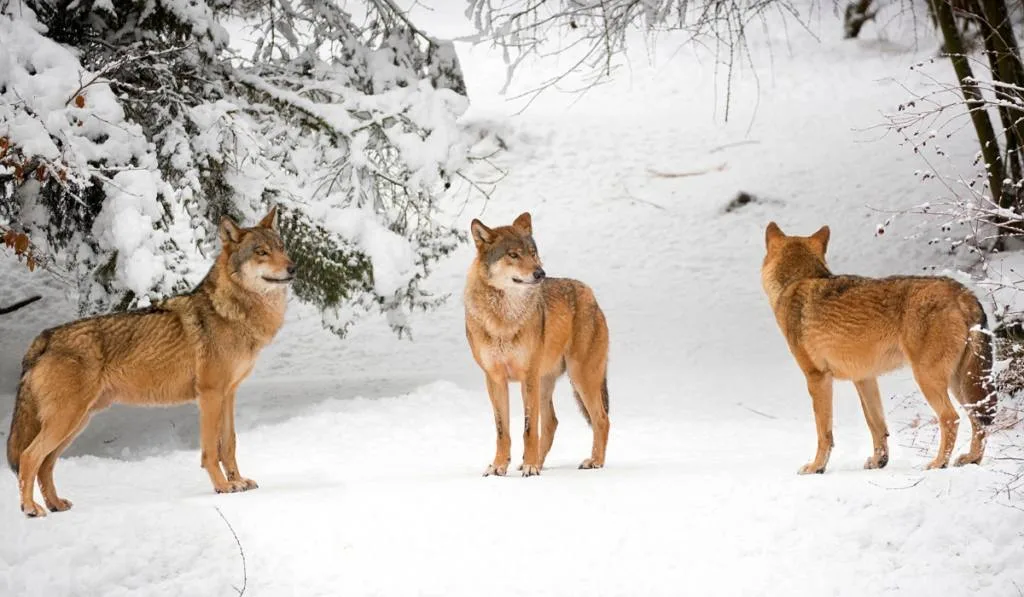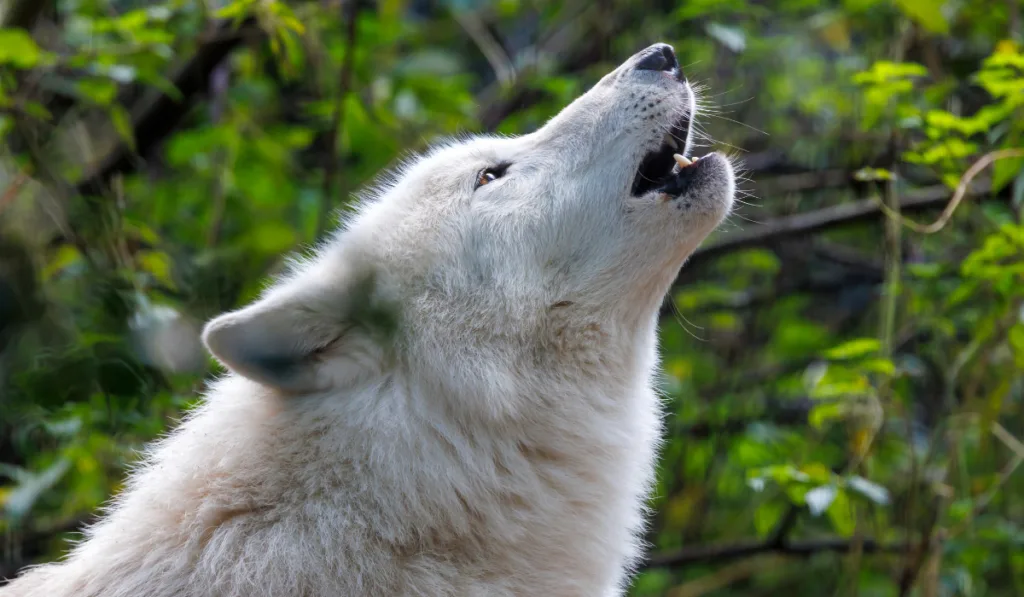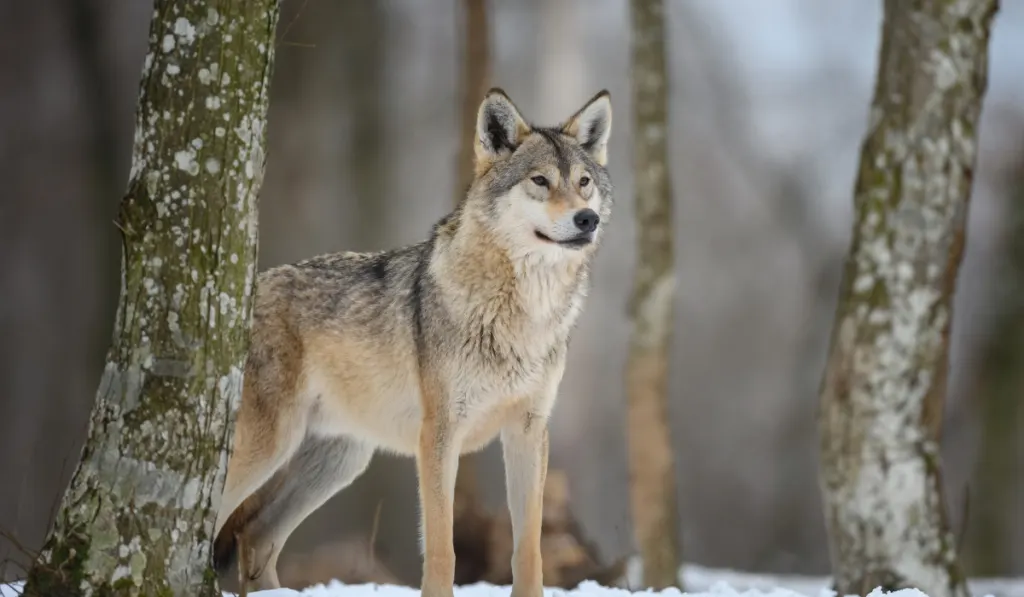Wolves are the largest members of the Canidae family. In other words, wolves are the largest canines.
Considering that dogs are also members of the canine family, it is not out of place to ask if wolves can bark.
Do wolves bark?
Wolves do bark. But it is a rather rare occurrence.
Wolves do not bark as dogs do. For one, adult wolves are infrequent barkers; you are more likely to hear the puppies bark.
Also, wolves typically bark to alert others unlike dogs that bark for various reasons.
Besides barking, wolves communicate through other means. They whimper, howl, and growl.
In total, wolves communicate vocally through 4 sounds. In this article, we shall shed more light on a wolf’s bark and their other vocal communications.

Table of Contents
Do Wolves Bark Like Dogs?
In a way, wolves bark like dogs; the sound of a barking dog and a barking wolf is similar.
In essence, dogs and wolves have similar voice boxes. But there are differences in their barking patterns.
The frequency of barking in dogs is higher than the frequency of barking in wolves, especially the adults.
Wolves rarely bark and adult wolves bark even less than their puppies.
If you hear a barking wolf, the chances that the sound is coming from a puppy wolf is relatively high.
Some experts even consider barking in young wolves a juvenile behavior.
One possible reason wolves do not bark as often as dogs do is that they bark for different purposes.
Dogs bark when they are bored, anxious, scared, trying to get attention, and a myriad of other reasons.
Wolves usually just bark as a way to alert the pack. They may also bark to show aggression while defending their group/pack.
Another possible reason wolves may not bark so many times is that their voices travel far.
So they could alert prey or predators to their presence. Either of these situations is not beneficial for them.
Besides barking, wolves make other sounds. In fact, you are more likely to hear these other sounds than a bark.
How Do They Communicate?
Wolves communicate through 3 means:
- Sounds
- Scents
- Body language
Body Language

Wolves are very particular about hierarchy in their pack, and body language is important in ensuring organization.
In a pack, the lead wolves stand tall and raise their tails high to show dominance.
The subordinate members of the pack, on the other hand, lower their bodies and tails as they paw at the dominant wolves.
Submissiveness can be expressed actively or passively amidst a pack.
When a wolf is actively submitting to a dominant member, the signs are obvious.
Such wolves typically tuck their tails, crouch, or lick their muzzle to show submission.
The said behaviors are first elicited by wolves when they are still pups.
Wolf pups use these actions when trying to get food from their parents.
When wolf pups are not mature enough to hunt yet, the adults carry meat in their stomachs and bring it to them.
The pups lick the muzzles or mouth of the adults. This causes the adults to regurgitate the meat and feed them.
In a situation where a wolf is passively submitting, it would lay on its back or side and expose its chest/abdomen to the dominant wolf.
The subordinate wolf may also pull leg muscle away so the dominant wolf can inspect them.
One typical instance of passive submission occurs when 2 wolves have a disagreement.
Two wolves may start by exposing their teeth, giving a fierce look, and growling at each other. But the less dominant one quickly submits by laying on its side or back.
When the subordinate wolf submits, the dominant one may tolerate it or may attack fatally.
Most times, when a dominant wolf attacks, the subordinate is an alien.
Other instances of body language in wolves involve the ears. When they are scared, they flatten their ears against their heads.
When they are wary, they pull their ears back and squint. When they are angry, they bare their teeth and raise their ears up straight.
Scents

Similarly to dogs, wolves have a great sense of smell. Hence, they communicate with scents easily.
Wolves practice scent-marking – an act where they mark their territories with scats and urine.
The scent from the scats and urine notifies any alien wolf that that area is taken.
Members of the pack can possibly recognize the scent of the scats/urine from their packmate. This may be one means of finding their way back if they get lost.
In some instances, dominant wolves scent-mark with their urine every 2 minutes.
While scent-marking, they assume a pose where they raise one leg. This pose is called Raised Leg Urination (RLU), and it is a form of communication.
Besides marking their territories with urine, wolves may also mark an empty food reserve with urine. This way, they know not to bother checking such reserves for food.
Besides urine and scats, wolves communicate through pheromones.
Pheromones only work as communication between the same species.
They are secreted in glands in areas such as the skin, toes, genitals, and anus. Pheromones play a significant role in reproduction in wolves.
Through pheromones in females’ urine, male wolves can identify those open to mating.
Sounds
Besides barking, wolves also whimper, howl, and growl.
Howling

Most people are very familiar with the howling of wolves. If you are familiar with werewolf movies, you have heard howling.
Similarly, if you’ve heard your dog howl, it’s pretty much the same thing wolves do.
Howling is how wolves communicate over long distances. They howl for 3 main reasons: defense, mourning, and socialization.
When wolves howl, they may be trying to bring the members of the pack together. At the same time, wolves may howl when they are trying to keep outsiders away.
Since howls travel far, a lost member of the pack can be reunited with the pack when it hears the howls.
In another case, wolves may howl when a member of the pack dies. This is when they howl to mourn.
Then sometimes, they just howl for fun or to lay claim to their territory.
As important as it is to them, wolves rarely howl. In fact, they may not howl more than 1-2 times a day.
Wolves typically howl together, but sometimes a single wolf can howl alone. Even then, it isn’t long before other wolves join in.
Sometimes, wolves combine howl and bark sound to defend the pack or alert them of a predator. The bark-howl can also be used to drive an intruder away.
Growling
When a wolf growls, it is usually trying to warn of an intruder or predator. In some cases, a wolf might growl as a threat to a subordinate wolf.
So, besides body language, growling is another way wolves maintain hierarchical order.

Whimpering
Whimpers are typically non-threatening sounds in wolves. A wolf might whimper to get the attention of another wolf.
Wolves may also whimper when they are anxious, frustrated, or in a submissive position.
Whimpering could also mean they are happy. It all depends on the scenario, and perhaps, their body language while they whimper.
When a mother wolf whimpers at her pup, it shows that she is willing to nurse it.
In some cases, wolves may combine barks and whimpers when they are surprised or being submissive.
Why Wolves Do Not Bark Like Dogs
The environment and social groups in which dogs and wolves grow differ. Hence, the differences in the intricacies of their barking.
As domestic dogs started living with humans, their mode of communication changed to suit the environment.
Dogs realized that humans understood barking more than other forms of communication.
So, to foster easier communication with humans, they evolved to bark more than their predecessors (wolves).

Wolves, on the other hand, typically live amongst other wolves. Whether they bark, growl, whimper, or howl, they are easily understood.
So, they do not have to rely more on just one form of communication.
Of course, dogs still use other forms of communication present in wolves. Dogs howl, whimper, and growl too.
But they bark more than wolves because it appears to be what humans understand better.
Final Thoughts
Wolves do bark; they communicate in various ways, including sounds, scents, and body language.
One of the sounds they make is the bark sound, and it sounds similar to a dog’s bark.
But there’s one big difference between a dog’s bark and a wolf’s bark. This difference is how often they bark. Compared to dogs, barking is very rare in wolves.
Resources
- https://www.thelabradorsite.com/do-wolves-bark/
- https://www.quora.com/Can-wolves-bark
- https://wolf.org/wolf-info/basic-wolf-info/biology-and-behavior/communication/#
- https://www.rspcapetinsurance.org.au/pet-care/dog-care/why-is-my-dog-barking#
- https://www.quora.com/Are-wolves-able-to-bark-or-do-they-just-refrain-from-doing-so
- https://wolf.org/wolf-info/wild-kids/wolf-families

